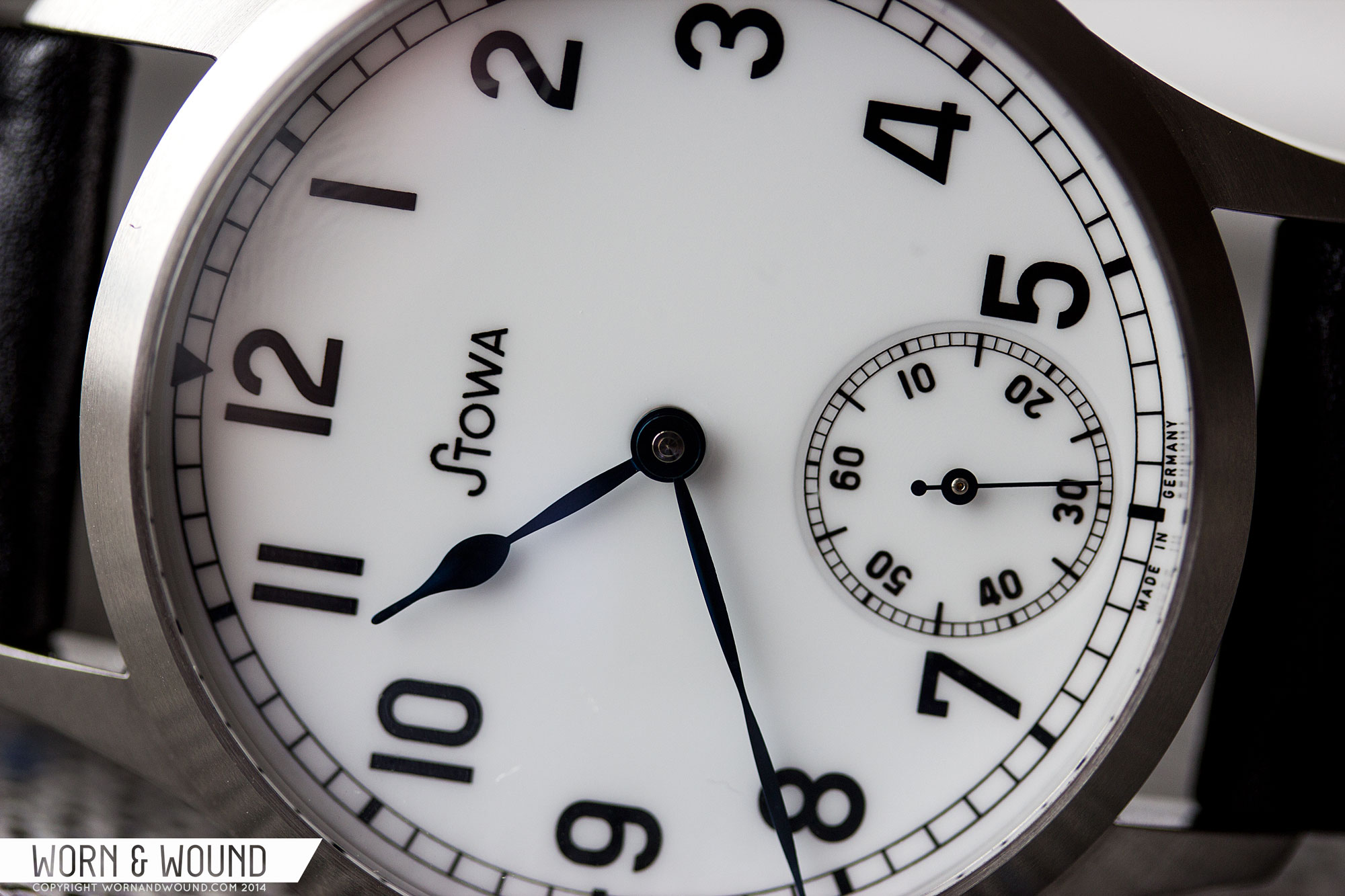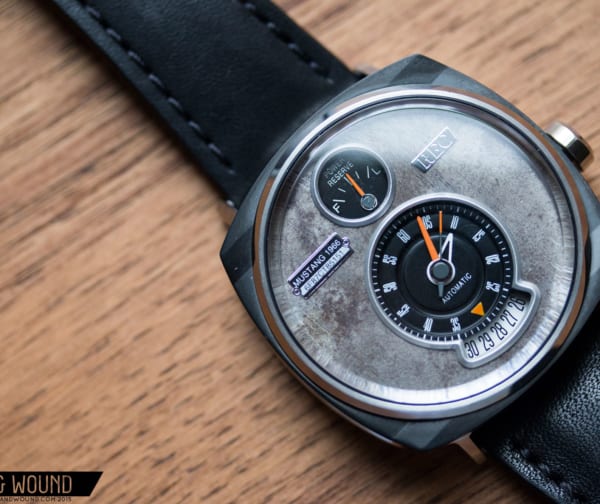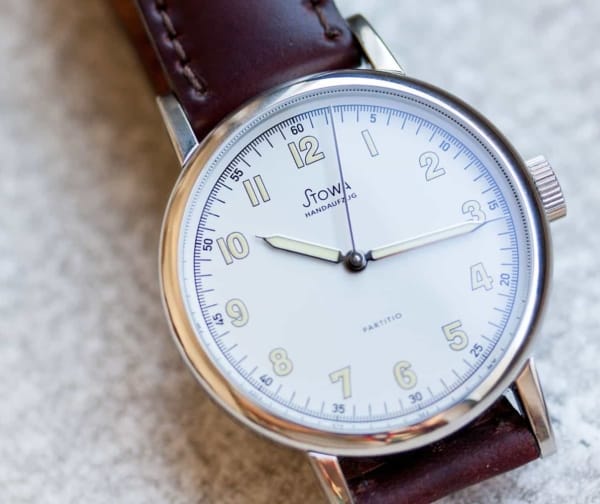If you’re into German watches, you’re likely already very familiar with Stowa. If not, here’s the super abbreviated history. Stowa was founded in 1927 by Walter Storz, (Stowa being an abbreviation of his name STOrz WAlter). In the 30’s they designed and released Bauhaus watches, which informed their very popular Antea line available today. Famously, of infamously as it might be, they were one of the original manufacturers of Flieger watches during WWII. Their original factory was also blown up during said war. They moved to another area in Germany and continued to make watches for many decades. In 1996 Jörg Schauer, a renowned German watch maker, took over the brand and all trademark rights. By introducing watches closely based on the brand’s history as well as new, modern watches, such as the Seatime Prodiver, all while maintaining accessible prices, Schauer has reestablished Stowa as a popular brand.
One of their historical lines that has always intrigued us is their Marine line. Based on the Marine Beobachtungsuhr pocket watches manufactured by Stowa for the German Navy in the 40’s, the Marine line speak to Deck clocks, and a nautical aesthetic that is very appealing. One of many “Marine Chronometer” type watches out there, the Stowa has a style that speaks to its German heritage by way of the typefaces used, and an exacting execution. There are several varieties of the Marine made by Stowa, including various case finishes, some dial variations and either an automatic or a manual movement. Today, we’ll be taking a look at the manually wound Marine Original, which is powered by a Unitas 6498-1. The watch features sapphire crystals front and back, a beautifully finished movement and a price tag of about $1,177 (878.15 EUR).
Stowa Marine Review
 Case: Steel
Case: Steel
Movement: Unitas 6498-1
Dial: Gloss white
Lume: No
Lens: Sapphire
Strap: Leather
Water Res.: 50M
Dimensions: 41 x 50 mm
Thickness: 12 mm
Lug Width: 22 mm
Crown: 7.5 x 4 mm
Warranty: Yes
Price: $1,177 / 878.15 EUR
Case
If there was a singular word I could choose to describe the Stowa Marine as a whole, it would be “purposeful”. Nothing is extraneous, nothing is overly elaborate…the only superficial details are on the movement, and that speaks to tradition. As such, things like the case are almost plain or dull on their own. Only in the context of the complete watch, do they come together.
The case is a nice midsize at 41 x 50 x 12mm (to the top of the domed sapphire), especially for a Marine watch with a Unitas movement, which tend to be in the 44mm range. The design is simple and classic, with slab sides, contoured lugs and a wide angled bezel. The whole thing is completely evenly brushed without a beveled edge or hint of polish anywhere. That said, it’s well executed, with sharp edges and a nice even satin sheen.
Coming off at 3 is a stout crown that measures 7.5 x 4mm. It has nice deep teeth making it easy and pleasant to grasp and turn when winding or setting the watch. The outside face has been adorned Stowa’s abstract logo as a deep engraving that is well executed. Around that, the area has been milled out a bit, leaving a concave channel that simply makes it more interesting than a flat surface would have been. Aesthetically, the crown is industrial and rugged, bringing out the more functional, instrument based side of the design.
Flipping it over, you are presented with a very wide sapphire crystal display, showing off the decorated movement. Since the case is 41mm and the Unitas movement, which once was a pocket watch movement, is quite large, the edge is very thin, maximizing the view of the movement. Everything else about the watch is almost utilitarian, so having this view of the mechanism is refreshing.
Dial
When it comes to classic Marine Chronometers, you pretty much always know what you are going to get when it comes to the dial. Big numbers, railroad indexes, black on white, blue hands, etc… The hand-wound Stowa Marine Original, being closely based on a pocket watch from their own archives, stays very true to this. Their automatic version differs a bit by way of having three hands and a date, but ultimately looks the part as well.
That said, no two brands make the exact same thing, with subtle differences in execution giving them each their own personalities. The Stowa is perhaps the most severe and, well, Germanic of the options out there. The hours index consists of large numerals in a harsh, sans-serif geometric font with fixed widths. Given that the Navy pocket watch it’s based on is from the 40’s, it’s likely that this is a DIN 1451 typeface, which were typefaces that met a Government standard set in 1931, and were used in various implementations such as traffic signs and license plates. It’s usage here is interesting as it brings a modern typeface into a design that also has classical elements.
Around the edge of the dial is a railroad index with heavier markers per hour. At 12 is a small triangle and 3, 6 and 9, the heavy line is slightly wider than the “tracks”. It’s a nice and subtle detail that gives the watch a bit of character. My favorite dial element is the sub-seconds at 6, which is indented into the surface a bit. Generally a standard find on Marine watches, this large sub-dial is dense, adding weight to the lower half of the dial and a visual centerpiece. The design mimics that of the dial around it, though the numerals rotate with the angle.
The surface of the dial is gloss white, meant to have an enamel like appearance, speaking to it’s pocket watch ancestors. It has a very nice effect, making the black markers really jump out, and adding some interesting reflections, such as around the sub-dial. There is also a sense of depth that you get out of gloss dials that isn’t seen in matte, which is a bit hard to explain, but in person just makes it more attractive.
The hour and minute hands are classical “Poires” style in blue steel. They are very elegant and as the only curvaceous element on the dial, have a nice contrast to what’s around them. The blue steel, as per usual, also looks great, sometimes appearing black, other times a rich sapphire blue. The second hand is nicely executed as well. It’s impossibly thin, with a small circular counter weight. Though it’s tiny, you can still see a hint of blue from the steel.
Movement
The ETA/Unitas 6498-1 movement inside is one we’ve seen many times (including in last week’s review). It’s a robust, staple movement, often chosen for Marine watches given their pocket watch lineage. The 6498-1 features manual winding, 17-jewels, 46hr power reserve and sub-seconds. What sets it apart in the Stowa Marine is the decoration, which you get a great view of. On the main large plates, you have the standard Cote de Geneve and a milled, golden Stowa logo. Under the balance you have a plate of perlage, which makes the balance pop out. Throughout the movement are heat blued screws which add some nice color and contrast, as well as in theory providing corrosion resistance.
Stowa makes things a bit more interesting by also including a screw-balance and a swan neck regulator. Both components are not standard and give the movement a more old-school look. From a practical standpoint, I’m not sure if there is any benefit in this instance to a screw-balance (watchmakers care to comment?) though I have read that swan neck regulators are easier to adjust.
Straps and Wearability
As with all Stowa watches, you have a wide selection of straps to choose from when you order, at various price points. There are a few leather options, a metal mesh, and several colors of gator. Our sample came on their 22mm black Nappa leather strap with contrast white stitching. It’s a tapering design (22 > 18) with a decent amount of padding in it, giving it some rigidity. Interestingly, both keepers have big lines of stitching on them, which is a bit uncommon. Finishing the strap is a nice and simple, but slightly different thumbnail buckle. It’s very square and has both Stowa logos etched into it.
While there is a logic to having a black strap with white stitching on a white dialed watch with black markers, I didn’t really like them together. The strap is a bit too modern and sporty for the watch, as well as too sterile. Since everything is so clean and lacking in adornment, the watch can be a bit cold, so having a strap that adds some character is needed. The great thing about Marine watches is that they are very versatile, straddling the line between formal and sporty, so you can dress them up and down easily. A gator would work for a dress instance as would a metal mesh. A less padded, more vintage style leather strap is great for a more casual, stylish approach. Given the starkness of the dial, I think warmer strap colors balance it out better as well. A nice 22mm color 8 cordovan strap would be great on this too.
I tried it on a medium brown Hirsch Liberty as well as a khaki suede and really liked both. The Hirsch, which is a strap i’ve had for a while and is nice and beat up, gave the watch a more rugged feel that played off of the bushed case. The khaki suede made it look more vintage and perhaps more military, reinforcing the history in the design. Both make the watch very easy to throw on with jeans and an oxford and call it a day.
On the wrist, the Stowa Marine wears very well. Since it’s 41mm, it’s very easy to pull off and should fit most wrists. While there are plenty of 44mm Marines out there, I think the proportions and impact of the Stowa are spot on. Big enough to have a lot of presence and be very legible, small enough to be sensible and not ostentatious. While Marine watches are all very similar, they are not nearly as common as pilot watches, so this still feels very unique, and is definitely something you can make suit your style.
Conclusion
The Stowa Marine will appear to fans of the genre looking for an authentic example. The version seen here, with brushed case, arabic numerals and Unitas movement, is an interesting mix of classical and more modern design elements that really speaks to the German origins of the watch. The end result is that in can be a bit stark or cold, but with the right strap option, it comes alive and can easily fit into a collection. Marine watches are very versatile, so this could easily become one’s daily watch. For a more formal, classical option, the same watch is available with Roman numerals and a polished case.
At about $1,177 (will fluctuate with exchange rates) for this watch on the basic leather, it’s not cheap, but still a solid price for a German made watch, and a decent bit of the cost is going to the decorated movement. There is plenty of competition out there that comes in cheaper, but not with the same movement finishing, or history. So, in the end, it’s really a matter of wether you want to pay more for the authenticity. Surely, the execution will not disappoint. Of course, you could also just keep saving and go for their Marine Chronograph, which might be the coolest Marine-style watch out there.









 Featured Videos
Featured Videos



















Absolutely beautiful watch – I’ve been considering this style for some time. I’m troubled by the excessively long lugs, though – you mention that the 41mm case should be comfortable for most folks, but the 52mm lug-to-lug length is nearly a deal breaker for me. At least that’s right at what I consider a limit for aesthetics on my thin wrists.
Seems like they could have shaved a mm or two off each lug and made an even more versatile watch, considering the case dimensions are very reasonable.
possibly, though once you bring the lugs in, you limit the space for straps. I think they might also use the same case for their Fliegers too, so it had to be dual purpose.
I think they use the same cases in their automatic range, unless you meant the hand-wound fliegers. I’m not sure about those.
Out of curiosity, I checked the Stowa website for dimensions and they claim the Marine Original is 41/50.2mm (so 4.6mm lug lengths) – not trying to be difficult, but is the 52mm a typo? Their Flieger lineup and Marine A10 both have 40/48.6mm dimensions, or 4.3mm lugs. I won’t claim to be able to discern 0.3mm in a photo!
Even 4mm lugs fit leather bands easily, though, as the recently reviewed Melbourne Portsea is 40/48mm.
jeez…sorry about that, the 52 is a TYPO!! I’ll fix that right now… too many watches, got myself confused
All it means is that I can’t remove this watch from my ‘wish list’! Although I’m even more drawn to their 1938 Chrono – just amazing.
This is beautiful and makes me very excited for a project watch I’m preparing to work on.
Great review Zach, but either you’ve been wearing too many watches with rough edges on their case or it’s simply time to retire that shirt, your cuff edge is tattered.
ha ha…I think it’s unfortunately the latter.
It’s not tattered, it’s patinated!
Excellent review. Can’t wait for the side by side review of their Marine Chronograph and 1938 Chronograph.
Nice type shoutout! Away from my work computer, but the 4 does not look familiar in my (perhaps overkill) DIN collection. Seems like forever ago I even wrote a paper only that lovely typeface for my design degree.
In any case, lovely watch, lovely type, and a killer 4 – if anyone know what family that’s from, let me know. Junghans rocks a similar 4 on their Max Bills too I think?
I own one of these and it’s my absolute favourite watch, it almost always never leaves my wrist. I have mine on a Fluco padded cordovan strap and it looks great.
Instead of the crown pictured, you can request an onion crown (like on their fliegers) from Stowa when you order it. I think it gives the watch even more vintage charm.
Great review and great pictures!
Archimede also makes something similar with the same movement with small seconds. Any reason to pay a premium for this? I am looking forward to buy one B-uhr and one marine with the 6498 movement and Archimede really beats Stowa on price.
Archimede movements aren’t decorated
And my wait for a manually-wound Marine watch in a 38mm case goes on… :o(